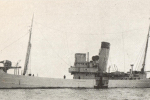Launched on 20th December 1934 from the Middlesbrough South Bank yard of Smith’s Dock Company Ltd (Yard No.981) for Henry Croft Baker and Sons of Grimsby the steel steam trawler Melbourne GY125 measured 157.0′ x 26.2′ x 12.0′ Her tonnage was 421 gross tons, 160 net tons. She was powered by a 99 nominal horse power triple expansion steam engine by Smith’s. Within a year of her launch and a short career on the fishing grounds around Iceland and the Faroes she was purchased in November 1935 by the Royal Navy and converted into an anti-submarine defence vessel. The conversion included fitting of a four inch gun to her foredeck. Renamed Topaze her Naval designation was T40.
In the years prior to the outbreak of war her crew trained hard for the action that was inexorably approaching as tensions with Germany grew. At the outbreak of WWII she was stationed at Campbeltown and participated in training exercises for British submarines and surface vessels until March 1941. She was then transferred to Portsmouth and took part in in Operation Dynamo, the successful evacuation of British forces from Dunkirk during April and May 1940. In April 1941, under the command of George Richard Gale RNR, she was back on the Clyde patrolling the Firth as part of the strong anti-submarine defences on the estuary.
On the 20th April the Nelson Class battleship HMS Rodney, passed through the boom at the Cloch Lighthouse, Gourock and quickly reached her cruising speed of 18 knots as she headed south through the Cumbrae Narrows. She was bound for Portsmouth where she was to join four destroyers tasked with escorting the liner MV Britannic across the North Atlantic to Halifax, Nova Scotia.
58 minutes after passing through the boom the Rodney smashed into Topaze sinking the trawler almost immediately. Nineteen of the twenty one crewmen aboard, including her skipper, were lost. The Rodney sustained only minor damage and continued south to escort Britannic on her transatlantic voyage. She was then to proceed to Boston to be repaired and refitted. However, en route, she was diverted to join the hunt for of the German battleship Bismarck in the North Atlantic and took part in the final battle which resulted in the sinking of the German Fleet’s flagship on 22nd May 1941.
The wreck of the Topaze lies in position 55° 40.747’N 004° 59.170’W (WGS84) a few miles south of Little Cumbrae. The wreck, which is broken in two parts close-by but substantially intact, lies oriented approximately 135°/315° with bow to NW. When last dived in 2007 the bow section was visually intact, with deck gun still in place, depth to the top of the focsle was 64 metres and seabed 69.5 metres. Moving aft the main deck is around 68 metres and middle of wreck appears broken (perhaps collision damage) before reaching the bridge area which rises to a least depth of 66.5 metres. Much of the bridge gear was still visible. Maximum seabed depth around the wreck when surveyed in 1984 was reported to be 75 metres.

































